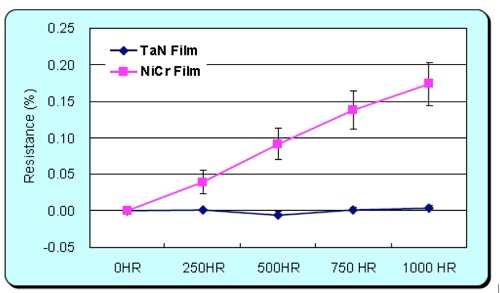BY KORY SCHROEDER,
Director of Marketing & Product Engineering
Stackpole Electronics
www.seielect.com
Advancements in thin-film materials and deposition technology have provided the market with reasonably priced precision resistors and allowed their use in a wide range of applications and end products. More specifically, unique materials and design have yielded precision chip resistors with higher power ratings, lower tolerance and TCR values, and resistance to moisture/humidity — all without the use of precious metals that increase costs. In addition, these cost-effective chip resistors are 100% lead-free and RoHS-compliant without exemption. There are clear advantages and disadvantages to using precision thin-film resistors. It is important to understand these advantages and disadvantages in order to select the right precision resistor for a given application or requirement.
Advantages
Precision thin-film resistors have progressed significantly in the past 10 years. The 0.1%-tolerance and 25-ppm TCR resistors that, in the past, were considered high-precision, expensive, and were difficult to find on the shelf anywhere are now commonly found in stock. It should be noted that E96 resistance values are the most popular and common from all manufacturers. When possible, engineers should focus their precision designs on the E96 series of values. In doing so, they will have a better chance of finding parts for a prototype or production build. While most thin-film resistor series are available in E192 values, these values will rarely be in stock, may not be marked, and may require a higher minimum-order quantity.
The overall electrical performance improvement for precision thin-film resistors compared to standard thick-film chips is dramatic (see Table 1 ). Beyond the obvious improvements possible in terms of tolerance and TCR, the measured performance characteristics to the industry standard tests show the impressive capability of precision thin-film chips.
Table 1: Precision thin-film resistors versus standard thick-film chips.
| Test | Precision Thin-Film Performance | Typical Thick-Film Performance |
| Short-Time Overload | ±0.05% | ±2% |
| Load Life | ±0.05% | ±3% |
| Biased Humidity | ±0.05% | ±3% |
| Resistance to Solder Heat | ±0.05% | ±1% |
Recent advancements in thin-film technology now allow production of surface-mount chip resistors with tolerances down to 0.01% and TCR down to 1 ppm. While this performance still lags behind that of bulk metal foil technology, the gap is narrowing. Furthermore, the cost differential between the highest-precision thin-film chip resistor and a comparable bulk metal foil resistor is more than an order of magnitude less. Now, design engineers with extreme precision requirements have reasonably priced choices that didn’t exist in the past. For example, Stackpole’s RNCF Series provides a wide range of sizes and resistance values in tolerances as tight as 0.01% and TCRs as low as 1 ppm/°C.

Disadvantages
There are two main disadvantages to thin-film technology. Pulse-handling for thin-film resistive elements is limited due to the small amount of resistive material present for this technology. For Nichrome thin-film resistive elements, which are the most abundant thin-film resistors in the market today, there is a possibility of moisture corrosion leading to resistance shifts and, eventually, open failures.
Pulse-handling for thin-film resistors is comparable to thick-film chip resistors for longer pulse durations of 1 s or longer. This is due to the higher relative density of thin-film elements compared to thick-film. However, for shorter pulse durations, the amount of energy handling dramatically decreases. For pulse durations of 0.1 ms, for example, the difference between thick-film chip pulse-handling compared to thin-film is roughly an order of magnitude. However, precision thin-film resistors are most often used in precision applications, measurement or monitoring, and highly accurate controls. These applications will typically have little or no pulse-handling required. If there are pulse conditions, then other pulse-limiting resistors can be used in conjunction with the thin-film resistors to limit their exposure to the pulse energy.
Moisture corrosion is a potential cause of failure for standard Nichrome thin-film chips. Moisture causes the metals in the thin-film element to oxidize, making them non-conductive and eventually leading to positive resistance shifts and open-circuit failures. Fortunately, there are several options to remedy this problem. For example, Stackpole’s RNCS series is a proprietary passivated Nichrome thin-film technology that provides a moisture proof barrier protecting the resistive element. In 3,000-hour biased humidity testing, the passivated Nichrome thin-film technology shows very little resistance shift. For applications that require the highest resistance to moisture corrosion, Tantalum Nitride technology can be utilized. Tantalum Nitride thin-film resistors can withstand thousands of hours under biased humidity with almost no significant resistance shift at all.
Summary
Design engineers now have a thin-film SMD alternative that offers a broad resistance and size range, tolerances as tight as ±0.01%, and TCR down to 1 ppm/°C. The thin-film resistors utilize new materials and innovative designs that provide an inherent resistance to harsh environmental conditions like moisture and humidity while lowering costs. Designed to meet the requirements of a wide range of applications that need precise performance, thin-film SMD resistors deliver the ruggedization and long-life performance without degradation.
Advertisement
Learn more about Stackpole Electronics





